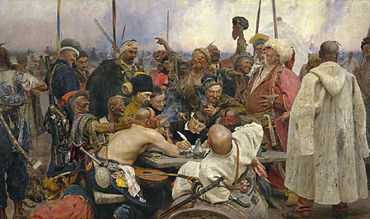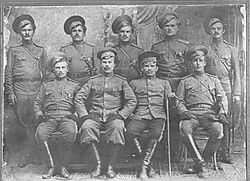Ural Cossacks
| Part of a series on |
| Cossacks |
|---|
 |
| Cossack hosts |
| Other groups |
| History |
| Cossacks |
| Cossack terms |
The Ural Cossack Host was a cossack host formed from the Ural Cossacks -- those cossacks settled by the Ural River. Their alternative name, Yaik Cossacks, comes from the old name of the river.
History

The Yaik (Ural) Cossacks although speaking Russian and identifying themselves as being of primarily Russian ancestry also incorporated many Tatars into their ranks.[1] According to Peter Rychckov some these Tatars called themselves Bulgarians of Khazar origin, and the first Yaik Cossacks, including these Tatars and Russians, existed by the end of 14th century.[2] These Tatars might be both Chuvash people and Mishari (Meschera in Russian, Miser in Tatar language), the latter had not only Moslems and Jews, but Christians among them to facilitate their merge with Russians[3][4] Meschera were important on Don as well. Later, as Pushkin wrote, a lot of Nogai joined Yaik Cossacks. Twenty years after the conquest of the Volga from Kazan to Astrakhan, in 1577 [5] Moscow sent troops to disperse pirates and raiders along the Volga (one of their number was Ermak). Some of these fled southeast to the Ural River and joined Yaik Cossacks. In 1580 they captured Saraichik together. By 1591 they were fighting for Moscow and sometime in the next century they were officially recognized. In 1717 they lost 1,500 men on the Alexander Bekovich-Cherkassky expedition to Khiva. A census in 1723 showed 3,196 men fit for military service.
Yaik Cossacks were the driving force in the rebellion led by Yemelyan Pugachev in 1773-1774. Their main livelihood was fishery and the taxation on it was a major source of friction between the Cossacks and the state. A revolt broke out in 1772, marked by the murder of General von Traubenberg. Traubenberg headed a commission which was to investigate and settle Cossack complaints and grievances, but his behaviour only antagonized them further. In reprisal, many were arrested, executed and outlawed. Pugachev appeared shortly after and managed to rally them to his cause.
The Yaik Cossacks were renamed as part of the Ural Hosy after the rebellion.
The Ural regiments later took part in Suvorov's Italian and Swiss expedition, the Great Patriotic War of 1812, the Russo-Turkish War, the November Uprising of 1830 and in the Crimean War. They also played a significant role in the Turkestan campaigns of the 1870s.
Distinctions
The distinguishing colour of the Ural Host was crimson; worn on the cap bands, epaulettes and wide trouser stripes of a dark blue uniform of the loose-fitting cut common to the Steppe Cossacks. High fleece hats were worn on occasion with crimson cloth tops.
References
- ↑ Wixman. The Peoples of the USSR, p. 51
- ↑ The origin of Yaik Cossacks http://www.yaik.ru/rus/forces/history/index.php?SECTION_ID=263&ELEMENT_ID=2542
- ↑ http://wikipedia.qwika.com/it2en/Avari
- ↑ A G Muhamadiev "The new opinion on the history of Huns, Khazars, the Greater Bulgaria and the Golden Horde", Kazan, 2011 А. Г. Мухамадиев «Новый взгляд на историю гуннов, хазар, Великой Булгарии и Золотой Орды»
- ↑ Alton S, Donnelly, 'The Russian Conquest of Bashkiria',1968, for this paragraph.